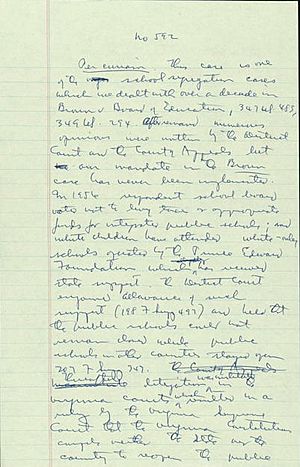Griffin v. County School Board of Prince Edward County facts for kids
Quick facts for kids Griffin v. School Board |
|
|---|---|

|
|
| Argued March 30, 1964 Decided May 25, 1964 |
|
| Full case name | Griffin v. County School Board of Prince Edward County |
| Citations | 377 U.S. 218 (more)
84 S. Ct. 1226; 12 L. Ed. 2d 256; 1964 U.S. LEXIS 1210
|
| Holding | |
| Closing public schools for the sole purpose of race and providing incentives to attend private segregated schools are violations of the Equal Protection Clause. United States Court of Appeals for the Fourth Circuit reversed. | |
| Court membership | |
| Case opinions | |
| Majority | Black, joined by Warren, Douglas, Brennan, Stewart, White, Goldberg, Clark (in part), Harlan (in part) |
| Laws applied | |
| U.S. Const. Amend. XIV | |
Griffin v. County School Board of Prince Edward County was an important case decided by the Supreme Court of the United States in 1964. The Court ruled that a county could not close its public schools to avoid racial integration. It also said that giving money for students to attend private, segregated schools was against the Equal Protection Clause of the Fourteenth Amendment. This ruling meant that all public schools in Prince Edward County, Virginia, had to reopen and be open to students of all races.
Contents
Why the Case Happened: School Closures
After the Supreme Court's decision in Brown v. Board of Education in 1954, which said that separate schools for different races were illegal, many places in the South tried to resist. In Virginia, this resistance was called massive resistance. It was a plan to keep schools separated by race.
Prince Edward County's Extreme Action
In 1959, the Prince Edward County Board of Supervisors was told to integrate its public schools. Instead of following the order, the county took a very unusual step. They decided not to give any money to the public school system. This forced all public schools in the county to close down. They stayed closed for five years.
Impact on Students
Instead of funding public schools, Prince Edward County offered money, called tuition grants, to all students. This money was meant to help them attend private schools. However, there were no private schools for black children in the area. This meant that from 1959 to 1963, black children in the county had no formal education at all. All the private schools that did exist remained separated by race.
In 1963, some classes were finally held for both black and white students in county-owned buildings. But the county-funded public schools stayed closed.
The Legal Journey to the Supreme Court
The legal fight to reopen the schools continued. In 1959, a lower court had ordered the schools to open without segregation. But the county kept fighting this order. The case went through different courts, and eventually, the black schoolchildren appealed their case to the Supreme Court.
Lawyers like Robert L. Carter from the NAACP (National Association for the Advancement of Colored People) argued on behalf of the black students. The United States government also joined the case, supporting the students.
The Supreme Court's Decision
In 1964, the Supreme Court made its decision. Justice Hugo Black wrote the main opinion for the Court. The Court ordered that the public schools in Prince Edward County must reopen.
Why the County's Actions Were Illegal
The Court said that the county's actions were against the Equal Protection Clause of the 14th Amendment. This part of the Constitution says that all people must be treated equally under the law. The county had closed public schools and offered money only for private schools that did not accept black students. This was seen as a clear way to keep schools separated by race.
The Court stated:
For the same reasons the District Court may, if necessary to prevent further racial discrimination, require the Supervisors to exercise the power that is theirs to levy taxes to raise funds adequate to reopen, operate, and maintain without racial discrimination a public school system in Prince Edward County like that operated in other counties in Virginia.
A Major Ruling
This case was very important. It was the first time the Supreme Court told a local government that it had to use its power to collect taxes to fund public schools. This was a big step in making sure that schools were truly integrated.
Some justices, like Justice Clark and Justice Harlan, disagreed with this part of the decision. They felt that federal courts should not tell local governments how to use their tax money. However, the majority of the Court believed it was necessary to stop racial discrimination.


